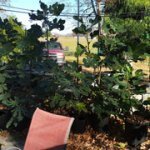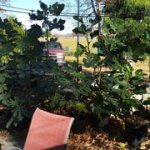DCallahan
Well-known member
I'm curious if anyone has any experience with amendments or applications to increase the frost tolerance in fig trees?
The way i understand it is that my local fruit orchards, Apple, Cherry, peaches and other stone fruits will apply Potassium in the spring to increase the frost tolerance of the trees with their young tender growth from late spring season frosts.
I'm asking because I'm making an observation within my collection of figs.
I have two sections both with fertigation systems.
My main section with mature trees and young 1st year trees mixed, got general purpose triple 20. These trees are all done for the season, either totally defoliated or frostbite and withering severely. With the total defoliation being greatest on the most mature trees and young first year trees holding on the most leaf. This behavior is as I would expect with the frost and weather we have experienced to this point in the season.
My secondary section is on my patio and is totally comprised of young first year trees. I initially feed them the same triple 20 fertilizer as the main section. But in late August I was concerned about getting the wood lignified. I switched to a blend called ''Hydroponic special'' 3-15-26 with increased amounts of micronutrients. to decrease the amount of Nitrogen but still feed them to a degree. These young trees still look fantastic! I know they are benefitting a little from the small microclimate on my stone patio, but other plants that aren't on the fertigation are showing signs of cold damage.
Im thinking this could be helpful in the spring if a simple application could be a precautionary safeguard for late season frost.
The way i understand it is that my local fruit orchards, Apple, Cherry, peaches and other stone fruits will apply Potassium in the spring to increase the frost tolerance of the trees with their young tender growth from late spring season frosts.
I'm asking because I'm making an observation within my collection of figs.
I have two sections both with fertigation systems.
My main section with mature trees and young 1st year trees mixed, got general purpose triple 20. These trees are all done for the season, either totally defoliated or frostbite and withering severely. With the total defoliation being greatest on the most mature trees and young first year trees holding on the most leaf. This behavior is as I would expect with the frost and weather we have experienced to this point in the season.
My secondary section is on my patio and is totally comprised of young first year trees. I initially feed them the same triple 20 fertilizer as the main section. But in late August I was concerned about getting the wood lignified. I switched to a blend called ''Hydroponic special'' 3-15-26 with increased amounts of micronutrients. to decrease the amount of Nitrogen but still feed them to a degree. These young trees still look fantastic! I know they are benefitting a little from the small microclimate on my stone patio, but other plants that aren't on the fertigation are showing signs of cold damage.
Im thinking this could be helpful in the spring if a simple application could be a precautionary safeguard for late season frost.






